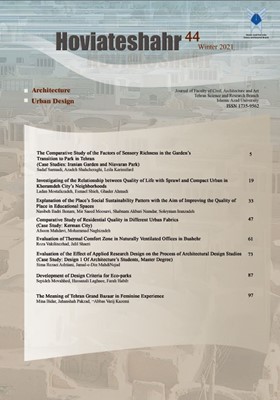ارزیابی محدوده آسایش حرارتی در اثر تهویه طبیعی در ساختمانهای اداری بوشهر
الموضوعات : architectureرزا وکیلی نژاد 1 , جلیل شاعری 2
1 - استادیار دانشکده هنر و معماری، رشته معمارى، دانشگاه شیراز، شیراز، ایران.
2 - دانشجوی دکتری معماری، دانشکده هنر و معماری دانشگاه تربیت مدرس، تهران، ایران
الکلمات المفتاحية: بوشهر, آسایش حرارتی, تهویه طبیعی, ساختمان اداری,
ملخص المقالة :
تأمین آسایش حرارتی از مهمترین اهداف طراحی ساختمانهاست که مقادیر عمده مصرف انرژی را شامل میشود. در ساختمانهای اداری آسایش حرارتی بر کیفیت محیط و کارایی کارکنان تأثیر بسزایی دارد. با توجه به تفاوت محدوده آسایش در ساختمانهای تهویه مطبوع و تهویه طبیعی و نبود استانداردهای مناسب در این زمینه در ایران، ضرورت انجام پژوهش خاصه در ساختمانهای برخوردار از تهویه طبیعی مشخص میشود. مقاله حاضر با هدف تعیین محدوده آسایش حرارتی در ساختمانهای اداری تهویه طبیعی در بوشهر بهصورت تجربی انجامشده است. با انجام مطالعات میدانی، عوامل محیطی (دما، رطوبت، سرعت باد) در بازه زمانی مناسب جهت کاربرد تهویه طبیعی، اندازهگیری شده و تعداد 180 پرسشنامه توسط کاربران و مراجعهکنندگان فضا پاسخدادهشده است. نتایج پژوهش نشان میدهد دمای بالای آسایش در این فضاها 6/28 درجه سانتیگراد و بالاتر از میزان پیشبینیشده طبق معادلات است. این مسئله لزوم انجام پژوهشهای گسترده جهت تعیین محدوده دقیق را نشان میدهد.
انصاری منش، مریم؛ و نصرالهی، نازنین. (1393). تعیین محدوده آسایش حرارتی ساکنان بهمنظور بهینهسازی کیفیت محیط داخل در ساختمانهای اداری کرمانشاه. نقشجهان، 2(4)، 11–21.
بهزاد فر، مصطفی؛ و منعام، علیرضا. (1393). تأثیر ضریب دید به آسمان در آسایش حرارتی کاربران فضای باز شهری، بررسی بوستانهای منتخب شهر تهران. معماری و شهرسازی آرمانشهر، 5(3)، 23–34.
حسینی، سید ابراهیم؛ شعبانی، سیده حمیده؛ عباسیان، غزاله؛ و بلانیان، ندا. (1393). بررسی تأثیر عوامل میکرواقلیم بر آسایش محیطی فضاهای پیاده شهری (نمونه موردی: بررسی آسایش حرارتی در خیابان شهرداری تهران، حدفاصل میدان تجریش تا میدان قدس)، مطالعات مدیریت شهری، 19(6)، 1–15.
حیدری، شاهین. (1393). سازگاری حرارتی در معماری نخستین قدم در صرفهجویی مصرف انرژی. تهران: دانشگاه تهران.
نجفی، سیدمحمدعلی؛ و نجفی، نجمه. (1391). بررسی آسایش حرارتی با استفاده از روشهای PMV و PPD، مطالعات محیطی هفت حصار، 1(1)، 61–70.
وکیلینژاد، رزا. (1392). تأثیرترکیبیویژگیهایکالبدیپوستهبناوالگوهای تهویهبرمیزانمصرفانرژیدرساختمانهای مسکونی (نمونهموردیساختمانهایتهویهیکطرفهدراقلیمگرمو خشکشیراز). پایاننامه دکتری، دانشگاه علم و صنعت ایران، تهران.
ASHRAE. (2004). Standard 55-2004:Thermal Environmental Conditions for Human Occupancy. Atlanta:Author.
ASHRAE. (2010). ASHRAE 55-Thermal environmental conditions for human occupancy. Atlanta:Author.
Auliciems, A., & De Dear, R. (1998). Thermal adaptation and variable indoor climate control In A. Auliciems (Ed.), Human Bioclimatology Advances in Bioclimatology (Vol.5, pp. 61–86). Berlin: Springer.
Auliciems, A., & Szokolay, S.V. (1997). Thermal comfort In A. Auliciems (Ed.), PLEA notes: Passive and Low Energy Architecture International Design tools and techniques thermal (Vol.5, pp. 1–66). Brisbane: University of Queensland.
Barbadilla-Martín, E., Lissen, JMS., Guadix Martín, JG., Aparicio-Ruiz, P., & Brotas, L. (2017). Field study on adaptive thermal comfort in mixed mode office buildings in southwestern area of Spain. Building and Environment, 123, 163-175.
Busch, J.F. (1992). A tale of two populations: thermal comfort in air-conditioned and naturally ventilated offices in Thailand. Energy and Buildings, 18 (3–4), 235–249.
de Dear, R.J. (1998). A global database of thermal comfort field experiments. ASHRAE Transactions, 104, 1141-1152.
de Dear, R.J., & Brager, G.S. (2002). Thermal comfort in naturally ventilated buildings: revisions to ASHRAE Standard 55. Energy and Buildings, 34(6), 549–561.
Djongyang, N., Tchinda, R., & Njomo, D. (2010). Thermal comfort: A review paper. Renewable and Sustainable Energy Reviews, 14(9), 2626–2640.
Ghiaus, C., & Allard, F. (2006). Potential for free-cooling by ventilation. Solar Energy, 80(4), 402–413.
Indraganti, M., Ooka, R., Rijal, H., & Brager, G. (2014). Adaptive model of thermal comfort for offices in hot and humid climates of India. Building and Environment, 74, 39-53.
Luo, Z., Zhao, J., Gao, J., & He, L. (2007). Estimating natural-ventilation potential considering both thermal comfort and IAQ issues. Building and Environment, 42(6), 2289–2298.
Luo, M., Cao, B., & Damiens, J. (2015). Evaluating thermal comfort in mixed-mode buildings: A field study in a subtropical climate. Building and Environment, 88, 46-54.
Lu, S., Pang, B., Qi, Y., & Fang, K. (2018). Field study of thermal comfort in non-air-conditioned buildings in a tropical island climate. Applied Ergonomics, 66, 89-97.
Mishra, A.K., & Ramgopal, M. (2013). Field studies on human thermal comfort: An overview. Building and Environment, 64, 94-106.
Mishra, A.K., & Ramgopal, M. (2015). A thermal comfort field study of naturally ventilated classrooms in Kharagpur, India. Building and Environment, 92, 396-406.
Mishra. A.K., Derks, M.T.H., Kooi, L., Loomans, M.G.L.C., & Kort, H.S.M. (2017). Analysing thermal comfort perception of students through the class hour, during heating season, in a university classroom. Building and Environment, 125, 464-474.
Nicol, F. (2004). Adaptive thermal comfort standards in the hot–humid tropics. Energy and Buildings, 36(7), 628–637.
Nicol, F., & Roaf, S. (1996). Pioneering new indoor temperature standards: the Pakistan project. Energy and Buildings, 23(3), 169–174.
Nicol, J., & Humphreys, M. A. (1973). Thermal comfort as part of a self-regulating system. Building Research and Practice, 1(3), 174–179.
Olesen, B.W., & Brager, G.S. (2004). A better way to predict comfort: The new ASHRAE standard 55-2004. ASHRAE Journal, 46, 20–26.
Olesen, B.W., & Parsons, K.C. (2002). Introduction to thermal comfort standards and to the proposed new version of EN ISO 7730. Energy and Buildings, 34(6), 537–548.
Orosa, J.A., & Oliveira, A.C. (2011). Passive methods to address the sick building syndrome in public buildings. In S.A. Abdul-Wahab (Ed.), Sick Building Syndrome (pp. 481–492). Muscat: Springer.
Rupp, R.F., Vásquez, N.G., & Lamberts, R. (2015). A review of human thermal comfort in the built environment. Energy and Buildings, 105, 178–205.
Singh, M.K., Ooka, R., Rijal, H., & Takasu, M., (2017). Adaptive thermal comfort in the offices of North-East India in autumn season. Building and Environment, 124, 14-30.
Van Hoof, J., Mazej, M., & Hensen, J.L.M. (2010). Thermal comfort: research and practice. Frontiers in Bioscience, 15(2), 765–788.
Yu, W., Li, B., & Yao, R.(2017). A study of thermal comfort in residential buildings on the Tibetan Plateau, China. Building and Environment, 119, 71-86.
Thermal Comfort, Office Building, Natural Ventilation, Bushehr
_||_

